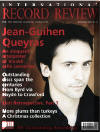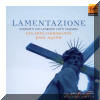Texte paru dans: / Appeared in:
*

International Record Review - 12/2011
Pour
s'abonner / Subscription information
Virgin
0709072

5099907090721
Paul Agnew has been singing with Les Arts Florissants for nearly 20 years now. Veteran director William Christie reckons it’s time for change; he’s convinced that ‘Paul could play a new role ... that he has the qualities to direct some projects himself’. This is his first recording in the driving seat, made not in the safety of a studio but live at the Ambronay Festival in September 2010. In his booklet notes Agnew admits that this programme was never conceived as a recording project, but that finding themselves at the end of their tour in Ambronay Abbey, they decided that the fabled acoustics were so perfect for the repertory that getting out the microphones impossible to resist.
The five choral works included here all make use of a deliberately archaic idiom known today as the stile antico, a highly prized technique which sought to revive the essence of the sixteenth-century a cappella style, if not its exact technique. To a greater or lesser extent all five works use imitative polyphony and rich, complex textures to express the power and anguish of their texts with highly charged harmonies and passages of’ strong chordal declamation. In these heightened Holy Week texts Christ’s Crucifixion is viewed from the standpoint of the Virgin Mary (Stabat mater) and affirmed in the immutable text of the Mass (Crucifixus); the two Marys anticipate the Resurrection (Quam amarum est, Maria), and man’s plea for mercy and redemption is given voice in the words of Psalm 51, the Miserere.
The most popular of Domenico Scarlatti’s sacred works during the eighteenth century was his C minor Stabat mater, possibly written while he was musical director of the Cappella Giulia at St Peter’s in Rome (1715-19). The music is generously scored for a ten-part choir with a simple continuo accompaniment, but although Scarlatti gives the impression of marshalling great forces, the ten voices in fact sing together for only around ten per cent of the time. Even so, the singers here make the most of every moment of sonorous togetherness, and even in the reduced-voice passages Agnew uses his full complement of singers. Although a few manuscripts suggest frequent solo-tutti division of the voices, Agnew (unlike many other conductors) avoids the use of soloists apart from two very short passages of obvious solo-tutti dialogue. The result is to throw the emphasis on Scarlatti’s highly expressive text expression, which Agnew and his team respond to vividly, but without the dramatic gestures or excessive theatricality which might disrupt the unfolding of this extraordinary essay in extended, controlled a cappella writing. Agnew achieves a measured flow of emotion, from moments of sublime acceptance to those of almost graphic violence, while consistently making it clear that in the varied textures, virtuoso flourishes (‘Inflammatus’) and a general preference for triple metre, Domenico Scarlatti was a true son of the Baroque.
Leonardo Leo ‘s Miserere (1739) tries harder to recapture the splendour of earlier church music, and Agnew follows suit with a seriousness of purpose designed to make the most of the block contrasts inherent in the work’s strict alternatim style. Here choral verses alternate with a simple plainsong line sung by a single voice accompanied by the organ. As the work progresses, Leo splits the singers into two four-part choirs which converse with each other but, as in Scarlatti’s Stabat mater, the full eight-part texture is sparingly used. The singers here take particular delight in the discovery that from Verse 10 Leo begins to integrate the plainsong tone into the choral counterpoint with great skill and beauty; the basses clearly enjoy themselves in Verse 16 when it’s their turn. This is the most convincing performance I’ve ever heard of this once popular but now seldom-heard masterpiece of the stile antico, which Wagner once described as ‘a mighty cathedral’ following a performance in Naples during Holy Week 1880.
The Stabat mater and Miserere are the two big works in the programme, and around them are arranged ultra-expressive settings of the Crucifixus: two by Antonio Lotti and one from the pen of Antonio Caldara - in eight, ten and 16 parts respectively. The bittersweet harmonic language, full of arresting dissonances, is toe-curlingly delicious, and Les Arts Florissants relishes every gorgeous suspension with just the right amount of bite.
The odd piece out here is the motet Quam amarum est Maria (1655) for two solo sopranos by Giovanni Legrenzi (who taught both Lotti and Caldara). It makes a refreshing break from the richer surrounding textures and adopts a fashionably secular style: an effective fusion of the lament and love duet which Hannah Morrison and Maud Gnidzaz deliver with exceptional delicacy and tonal focus — two sopranos I’d like to hear more of.
So, those of us familiar with Paul Agnew’s colourful theatrical turns for Les Arts Florissants in the past might be surprised that he should make his conducting début with a backward-looking, deliberately archaic set of late-Baroque choral laments. Agnew argues that this is in fact ‘dramatic music’ albeit ‘composed within the constraints of a reinterpreted polyphonic tradition’. His approach is to find a balance between the ‘reverential’ style of performance prescribed by the church and the natural inclinations of the composers, all of whom wrote primarily for the opera house. He succeeds very well, though these live performances are not without a few extraneous noises and the very occasional passage of indelicate intonation. Overall though, my toes curled appreciatively throughout — a reaction I always trust.
Cliquez l'un ou l'autre
bouton pour découvrir bien d'autres critiques de CD
Click either button for many other reviews


